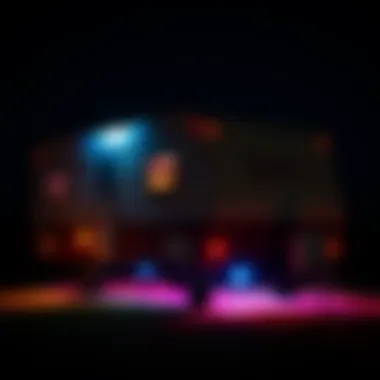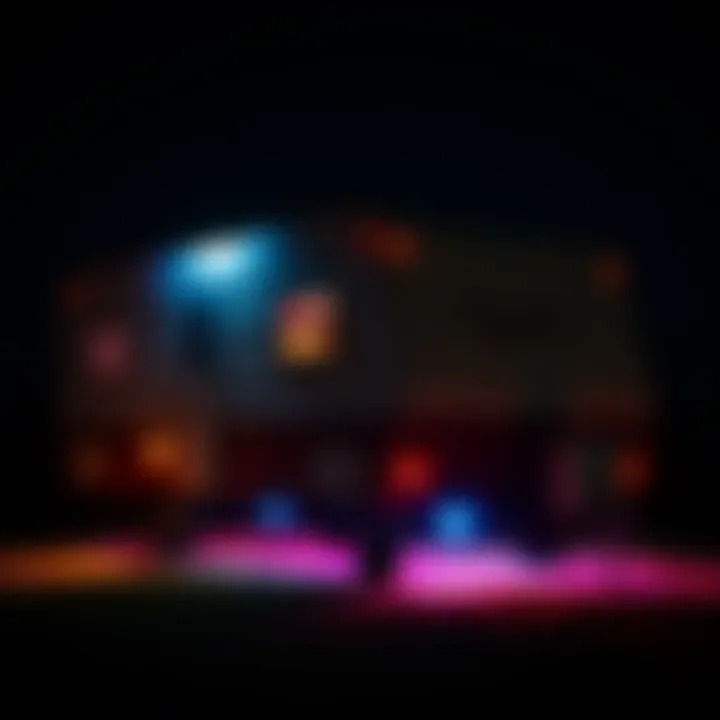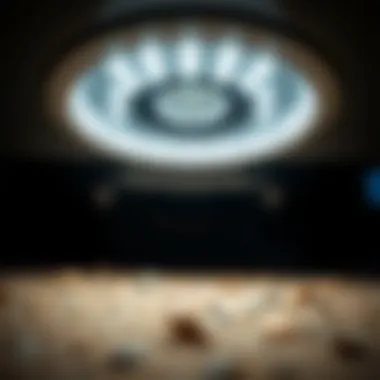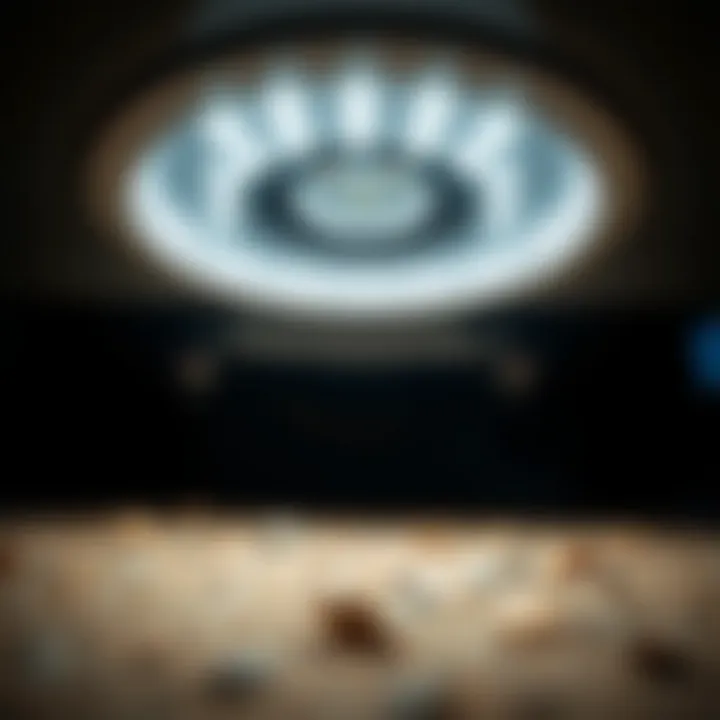Exploring the Benefits of LED Under Camper Lights


Intro
As campgrounds become a canvas for adventure seekers, a growing number of outdoor enthusiasts are turning to LED under camper lights. These lights do more than just illuminate the space below; they enhance safety, set the mood, and increase functionality at night, crafting a whole new experience around camping. By shedding light where it's needed most, they provide not only a practical solution but also an aesthetic touch to nature's backdrop.
The advantages of LED lighting over traditional options cannot be overstated. Lower energy consumption, longevity, and vividness make them a wise choice. But before diving into their technical aspects and user stories, it’s essential to understand the broader landscape of camper lighting. Looking at the recent trends and consumer preferences sheds light on why these features have caught the attention of so many.
Market Research Overview
Industry Trends and Insights
The outdoor and recreational vehicle lighting market has undergone significant evolution in recent years. According to reports from sources like Statista and IBISWorld, the increasing shift toward electric and eco-friendly options has positioned LEDs as the frontrunners in camper and vehicle lighting. Consumers are looking for durable, efficient solutions that complement their lifestyle, and LEDs fit that bill perfectly.
Key trends include:
- Sustainability: With a focus on reducing carbon footprints, many consumers are pushing for energy-efficient solutions that don’t compromise on brightness.
- Smart Technology: Some recent models come equipped with Bluetooth connectivity, allowing users to control their lighting remotely. This convenience is a game-changer for many backpackers.
- Customization: The capacity to tailor light intensities and colors is on the rise, as folks seek to personalize their camping experiences.
Consumer Demographics
The community of LED under camper light users is broad, spanning various demographics. From tech-savvy millenials with an appreciation for gadgets to seasoned campers who value reliability, it is apparent that functionality is a common theme.
- Age: Predominantly between 25 to 55 years old.
- Interests: Camping, nature exploration, off-road adventures.
- Behavior: Engaged in online forums and social media groups where they share experiences and advice.
This broad demographic engagement indicates a vital shift in how outdoor activities are perceived. Campers today want more than just an escape; they seek experiences enhanced by technology. An exploration into how these demographics benefit from LED under camper lights will unfold later in the narrative.
"In the wilderness, visibility is essential not only for navigation but also for safety and enjoyment. LED under camper lights serve as a beacon of practical innovation for outdoor adventurers."
Prologue to LED Under Camper Lights
In the world of camping and outdoor adventure, visibility can make a world of difference. When the sun dips below the horizon, the need for effective lighting becomes critical, especially for activities such as cooking, socializing, or simply navigating around your campsite. Enter LED under camper lights, a feature that has gained traction among enthusiasts for good reasons.
Traditional lighting options such as incandescent or fluorescent lights might provide some illumination, but they often fall short in terms of efficiency, longevity, and safety. LEDs, or Light Emitting Diodes, are the rising stars in this arena, presenting unique advantages that meet the demands of campers who prioritize functionality and convenience. By offering exceptional brightness with lower power consumption and an impressive lifespan, these lights transform how we experience the great outdoors after dark.
Heading out on a camping trip? You might consider your choice of lighting to be merely a secondary thought, something that sits quietly in the shadows of more pressing preparations, like packing your gear or planning your meals. Yet, not having sufficient illumination can seriously compromise your safety and enjoyment. Imagine stumbling around in the dark, not being able to locate gear or accidentally navigating into danger—definitely a recipe for disaster.
Moreover, LED lights enhance the aesthetics of your setup. When fitted beneath your camper, they can create a warm and inviting ambiance that welcomes you back after a long day of activities. Whether you are sharing stories around a campfire or enjoying a quiet evening with family, these lights can add to the entire experience.
Considerations also extend to installation and maintenance. Modern LED systems often come with user-friendly installation guidelines. Plus, the robust nature of LEDs means they are less prone to breakage compared to their more fragile counterparts. Just a quick setup allows you to pivot from day activities to nighttime fun effortlessly.
In summary, LED under camper lights are not just a luxury; they are an essential component that amplifies outdoor experiences, enhances safety, and lends a magical touch to evening settings. As we venture further into this guide, we’ll illuminate the specifics of LED technology, their advantages, the diversity of applications, and much more. Buckle up, because a world of bright possibilities awaits for campers who embrace this transformative lighting technology.
Understanding LED Technology
In the realm of modern lighting, LED technology stands out as a game-changer, especially for outdoor enthusiasts. Understanding how LEDs operate and what sets them apart from traditional lighting options is crucial for anyone considering upgrades to their camping setup. LEDs, or Light Emitting Diodes, convert electricity directly into light, which not only enhances their efficiency but also their versatility.
The significance of LEDs transcends mere brightness; they herald a new era in sustainable lighting. The low power consumption of LED under camper lights means longer battery life for vehicles when camping in remote areas, allowing enthusiasts to enjoy extended adventures without worrying about depleting their power source. This is particularly vital when you're out in the wild, far away from commotion and with limited access to electrical recharge.
Moreover, LED lights have a longer lifespan compared to their incandescent and fluorescent counterparts. Users often find themselves swapping out traditional bulbs yearly, but LEDs can shine for tens of thousands of hours. In addition, the durability of these bulbs means they are typically resistant to shock and vibration, making them ideal for rugged outdoor environments.
Ultimately, an understanding of LED technology provides practical insight into making informed decisions about camping lights, ensuring safety, sustainability, and convenience for outdoor activities.
What is LED?
Light Emitting Diodes (LEDs) are semiconductor devices that emit light when an electric current passes through them. At the core of each LED lies a microchip that converts this electrical energy into light. What distinguishes LEDs is the way they emit light; rather than relying on heated filaments like incandescent bulbs, they operate through electroluminescence.
The color of the light emitted can vary – from warm tones that mimic traditional bulbs to cooler shades more akin to daylight. The ability to customize light color is a big plus for campers who wish to create a certain mood at their campsite.


Another noteworthy point is that LEDs generate minimal heat in comparison to other types, reducing the risk of burns or fire hazards. This is an essential consideration when using lights in outdoor settings where dry vegetation may be present.
Advantages of LED Over Traditional Lights
- Energy Efficiency: LEDs consume much less power for the same light output compared to incandescent or fluorescent bulbs. For instance, while a traditional bulb might use 60 watts, an LED can achieve similar brightness with only about 10 watts.
- Longevity: The lifespan of LED lights can range from 15,000 to 50,000 hours or even more. This vastly exceeds the life of incandescent lights (around 1,000 hours) and makes for fewer replacements and better value over time.
- Durability: Unlike traditional glass bulbs, LEDs are made from more robust materials, making them less prone to breaking when handled or subjected to rough conditions.
- Lower Heat Emission: LEDs release very little heat, which means they are safer to touch and pose less of a fire risk.
- Variety of Colors and Designs: LEDs come in a wide spectrum of colors and designs, enabling campers to personalize their lighting according to their preference or activity.
To sum it up, shifting to LED under camper lights offers not just energy savings but also improved performance and safety. As more campers embrace this technology, they are opening doors to a more enjoyable and safer outdoor experience.
Applications of Under Camper Lights
The presence of LED under camper lights fundamentally transforms the experience of outdoor activities. More than just functional lighting, these fixtures embody convenience, safety, and an immersive ambiance. As camping enthusiasts increasingly embrace this technology, understanding its key applications becomes vital for anyone looking to elevate their outdoor experience.
Enhancing Visibility During Nighttime Activities
When darkness falls, the world around campers can become a shadowy expanse, making activities such as cooking, socializing, or even simply navigating around the campsite cumbersome. LED under camper lights provide a crucial solution to this problem by offering a bright, steady illumination that makes night activities much safer and more manageable.
Imagine trying to fry up bacon on a camping stove while struggling to see the pot; it can indeed ruin your whole morning. With LED lights, you can effortlessly see your culinary creations and avoid spills or accidents. Additionally, if it's time to take the dog for a walk or head to the restroom, having reliable visibility is essential. With the flick of a switch, these lights can banish the darkness, providing a comforting glow that makes navigating in the night feel almost second nature.
Improving Safety and Security
Beyond simple visibility, LED under camper lights play a pivotal role in enhancing safety and security at campsites. Camping often involves being in secluded areas where safety can be a concern, especially during the night. One of the benefits of installing robust LED lighting is the deterrent it provides to potential intruders or wildlife. A well-lit area is less inviting to those with nefarious intentions.
Furthermore, the ability to clearly see your surroundings can prevent slips, trips, or falls that might occur as you move about in the dark.
"Safe camping is happy camping!"
This adage rings especially true when you consider that adequate lighting not only keeps you safe while enjoying activities, but it also enhances peace of mind. You are less likely to be startled by unseen animals rustling in the bushes or to trip over unseen rocks.
Creating Ambiance at Campsites
While practicality often takes precedence, creating a pleasing atmosphere at your campsite cannot be ignored. LED under camper lights can be selected not just for their functional benefits but for their aesthetic appeal as well. Available in various colors and brightness levels, they lend themselves wonderfully to thematic setups or simply to enhance the natural beauty of the surrounding environment.
A well-lit campsite can foster camaraderie and connection among those gathering around a campfire. The soft glow from LED lights can accentuate the beauty of a starry night, making it easier to relax and enjoy each other's company or the splendor of nature. Whether it’s a gathering of friends sharing stories or family members making s'mores, ambiance is vital for a memorable experience.
To sum up, the applications of LED under camper lights are versatile and impactful. From enhancing nighttime visibility, boosting safety, to creating an inviting atmosphere, these lights are an indispensable asset for anyone passionate about outdoor adventures.
Technical Specifications of LED Under Camper Lights
When it comes to illuminating the great outdoors, understanding the technical specifications of LED under camper lights is crucial for both seasoned campers and newcomers alike. This section delves into the nitty-gritty details that forges a link between technology and practical use, ensuring that you get the most bang for your buck.
Technology in lighting has evolved rapidly, and LED lights stand tall above others due to their durability, energy efficiency, and versatility. But what do those specifications mean for a potential buyer or user? It's all about brightness, power consumption, efficiency, and how these factors play into everyday use on your camping trips.
Brightness and Lumens Explained
Brightness is a pivotal aspect when choosing LED lights. It's often measured in lumens—essentially figuring how much light is emitted from a source. The higher the lumens, the brighter the light. For context, a standard 60-watt incandescent bulb emits around 800 lumens. In contrast, an LED light that generates similar brightness only requires about 10 to 15 watts, making them hugely popular for campers looking to save on energy and extend their lighting hours.
Here’s how various lumen outputs translate into practical applications:
- 500-1000 lumens: Suitable for soft ambiance lighting and basic tasks like reading or enjoying an evening meal.
- 1000-2000 lumens: Good for general campsite lighting and providing enough visibility for activities like setting up tents.
- 2000+ lumens: This level is for serious illumination needs, great for outdoor events or situations requiring clear, bright light.
Under camper lighting should enhance your experience without being glaring or harsh, hence why selecting a fitting range is essential. In the end, it’s not just about brightness; it’s about creating a comfortable atmosphere that serves your needs effectively.
Power Consumption and Efficiency
The efficiency of LED lights is one of their most attractive qualities. Not only do they require less power, but they also convert a higher percentage of energy into usable light, minimizing energy waste. Power consumption is commonly measured in watts, and LED lights typically use around 75-80% less power than their incandescent counterparts. For avid campers, this translates to longer battery life and reduced energy costs, allowing for more camping trips on the same battery package.
To illustrate:


- LEDs: 15 watts for 1400 lumens
- Incandescent: 100 watts for same output, wasting energy as heat
A significant point to consider is that while LED lights may have a higher upfront cost, their longevity (often lasting 25,000 hours or more) coupled with their efficiency means increased savings over time. Less need for replacements also means fewer trips back to the store, giving you more time to enjoy the great outdoors.
In short, ensuring that you have a firm grasp on these specifications can elevate your camping experience. Consider brightness and efficiency well before the trip, and you’ll find your nights under the stars lit just right.
"In the world of camping, knowledge about your tools is as essential as having them."
For further reading on efficiency and how LED technology is shaping up the way you see your world, check out Wikipedia on LEDs and Consumer Reports on lighting options.
Understanding these specs gives you the ability to make more informed decisions, aligning technology with your unique camping needs.
Installation Process for LED Under Camper Lights
The installation of LED under camper lights is not just an optional task; it’s a critical step that can significantly improve both functionality and aesthetics of your camper. Proper installation ensures that the lights perform efficiently, offering the desired visibility and ambiance, while also safeguarding your electrical system from potential hazards. When you take the time to get this right, you're not just enhancing your camping experience but also investing in the longevity and reliability of your lighting solution.
Required Tools and Materials
Before embarking on the installation journey, gather the necessary tools and materials to ensure a smooth process. Here's a checklist to help you out:
- LED light strips or fixtures: Choose lights specifically designed for outdoor use, ensuring they weatherproof and durable.
- Power source: Usually, this involves a 12V battery or directly wiring into your camper’s electrical system.
- Wire connectors: These help to securely link the lights to your power source.
- Electrical tape: Essential for insulating and protecting your connections from moisture.
- Screwdrivers (Phillips and flathead): Handy for securing fixtures to your camper.
- Drill and drill bits: If you're mounting lights using screws, you'll likely need a drill.
- Wire strippers: To help expose the wire for efficient connections.
- Electrolyte grease: Adding this to wire connections prevents corrosion, especially important in outdoor settings.
Step-by-Step Installation Guide
Here’s a simple guide to walk you through the installation process. Like piecing a puzzle together, each step is essential to properly illuminate your evenings:
- Plan your layout: Think about where you want the lights. Under the chassis or along the sides can work well.
- Prepare the surface: Clean the designated installation area to ensure there’s no dirt or grease. Good adhesion relies on a clean surface.
- Measure and cut: If using LED strips, measure out the needed length and cut them carefully. Always double-check your measurements.
- Connect the wires: Strip about half an inch of insulation from the wire ends. Connect your LED lights to the power source using wire connectors.
- Secure the lights: Use screws or adhesive backing (if applicable) to mount the lights under the camper.
- Test the lights: Before sealing everything up, test the lights to make sure they work properly. Adjust if necessary.
- Seal connections: Apply electrical tape to your wire connections to keep moisture out.
- Final touches: Ensure all components are secured and tidy before use.
Safety Precautions to Consider
Working with electricity requires a level of caution that cannot be overstated. Here are some crucial safety tips:
- Disconnect power: Always ensure the power source is disconnected before beginning installation to avoid electrocution.
- Use weatherproof components: Ensure all materials are rated for outdoor use, mitigating risks when exposed to the elements.
- Check for obstructions: Be mindful of any existing wiring or components under the camper that could be damaged during installation.
- Follow local codes: Make sure your installation adheres to regional electrical codes to keep your camper safe and legal.
- Test after installation: Once everything’s set up, carefully inspect and function-test the lights for any concerns.
"Light is the symbol of truth." Ensuring a proper installation of your LED under camper lights can bring clarity not just to your camping space, but also to your overall outdoor experience.
By considering these crucial steps and safety protocols, you can successfully install LED under camper lights, enhancing your nights spent under the stars—one light at a time. When done correctly, it becomes more than just a lighting upgrade; it's about crafting an inviting atmosphere that resonates with adventure.
Comparative Analysis: LED vs. Other Lighting Technologies
When it comes to outfitting campers with lighting that meets both functional and aesthetic purposes, looking into various options can shed light on what will work best for your needs. This section digs deep into how LED lights stack up against traditional lighting technologies, specifically incandescent and fluorescent lights. Understanding these differences not only helps in making an educated purchase but also in optimizing energy efficiency, cost-effectiveness, and user satisfaction in the long run.
Incandescent Lights
Incandescent lights have long been the golden standard in travel lighting, prevalent in homes and vehicles alike. They produce light through heat, which is why they tend to run hot and be less energy-efficient. Here are some points to consider when comparing incandescent to LED:
- Brightness and Color Quality: Incandescent bulbs give off a warm light, which many folks find cozy. However, their brightness can vary significantly based on wattage.
- Energy Consumption: Incandescents burn a lot more juice — about 80-90% of the energy is wasted as heat rather than light. This can take a toll on your battery when out in the wild.
- Lifespan: Typically, an incandescent bulb lasts around 1,000 hours before it needs replacing. That's a major downside when you're looking to light up those late-night campfire chats without constant bulb replacement.
Overall, while incandescent lights provide a familiar glow, their inefficiency and shorter lifespan make them less suitable for modern camping setups where LED lights can do the job better.
Fluorescent Lights
Fluorescent lights offer a middle ground between incandescents and LEDs. They generate light by exciting mercury vapor, producing a cooler tone of illumination. Let’s break down some crucial aspects of fluorescent lighting:
- Energy Efficiency: These bulbs are more efficient than incandescents but not touching the efficiency levels of LEDs.
- Heat Output: They do run cooler than incandescent lights, reducing the heat concern. However, they still waste some energy as heat.
- Lifespan and Versatility: Usually, fluorescent lights last between 7,000 and 15,000 hours, but they can struggle in colder temperatures. Their flickering nature also doesn't sit well with some people who find it distracting.
In terms of camper-friendly lighting, fluorescent options can light up a space well, but may not offer the durability one might seek in outdoor conditions.


"The journey of a thousand campfires begins with a single light switch. Choose wisely."
For further reading on lighting technologies, you can check out resources from Wikipedia or the Encyclopaedia Britannica.
User Experiences and Testimonials
Understanding how LED under camper lights affect outdoor adventures is best seen through the experiences of those who have utilized them. Testimonials provide a real-world view that extends beyond manufacturer specifications and marketing jargon. They illuminate the practical benefits and any potential drawbacks faced by users, enriching the discussion surrounding these innovative lighting options.
While engaging in recreational camping, users often emphasize two significant aspects—affordability and durability. Each of these elements plays a critical role in establishing the overall value of LED lights within the camper community.
Affordability and Value for Money
When it comes to camping gear, affordability often dictates buyer behavior. Users rave about LED under camper lights being a cost-effective solution that doesn't skimp on performance or quality. High-quality LED lights such as the TechnoLite Series can be found at reasonable prices, often equating long-term savings due to their energy efficiency and lower replacement costs. Many campers reported outstanding experiences after investing in these lights, noting the following:
- Lower electricity costs: Since LED lights consume less power, campers can run them longer without draining their batteries. This leads to lower generator costs or extended battery life in off-grid situations.
- Minimal upkeep: With longer lifespans than traditional lights, users find themselves replacing LEDs less often, saving them from repeated costs and hassle.
- Versatile options: Access to various features, from brightness level adjustments to color temperature choices, provides flexibility without pushing the budget too high.
Such reviews consistently confirm users feel they get a solid bang for their buck. In their eyes, the upfront investment pays off handsomely over the years, making LED lights a smart choice for financially savvy campers.
Durability and Longevity of LED Lights
Durability comes hand in hand with LED technology, and this is backed by numerous user testimonials praising the resilience of their lights even in harsh conditions. Nobody wants a lighting setup that gives out when they need it the most—say during a sudden storm or a last-minute night fishing trip. Users often express their satisfaction with the following points:
- Weather resistance: A good number of LED under camper lights are designed to withstand elements like rain, snow, and extreme temperatures. Users have shared stories of their lights functioning perfectly in drizzles or amidst sweltering heat—proof that quality LEDs have guts.
- Impact resistance: Many report their LED lights remain intact even after unintentional bumps and scrapes from deploying and moving their gear around. Users appear to trust their lights to last through the physical challenges of camping life.
- Long lifespan: The average life expectancy of an LED is about 25,000 to 50,000 hours of use. This longevity means less frequent replacements, allowing campers to focus more on adventures instead of maintenance.
"Investing in quality LED under camper lights has illuminated not just my campsite but also my appreciation for the great outdoors. I can’t imagine camping without them now." - A seasoned camper's encounter.
Trends in Camper Lighting Technology
As the world becomes ever more interconnected and technology-driven, the sphere of camping and outdoor activities isn't left behind. Camper lighting technology, much like other facets of the industry, has seen significant evolution, particularly with the rise of LED lights. But what does this shift entail, and why does it matter?
The importance of embracing contemporary lighting trends, especially LED-related advancements, cannot be overstated. Camper lights have transitioned from being merely functional light sources to essential components that enhance the experience of outdoor enthusiasts. Here are some pivotal elements that underscore the relevance of these trends:
Integration with Smart Technology
One of the most striking trends is the incorporation of smart technology into camper lighting solutions. Imagine having the capability to control your lights from your smartphone or tablet, allowing you to adjust brightness and even color depending on the atmosphere you wish to create. Smart LED systems often come equipped to interface with mobile apps or voice-activated assistants, providing utmost convenience for campers.
- Remote Control: Many smart systems allow users to manage their lights remotely. This means you could switch on the lights before returning to your campsite, ensuring you arrive to a well-lit area after a long day of hiking or fishing.
- Adaptive Brightness: Some systems automatically adjust brightness based on the time of day or surrounding light conditions. This ensures you’re not blinded upon re-entering your cabin late at night.
- Mood Lighting: With various color options, smart lights can set the perfect ambiance. Whether it’s a serene blue for relaxing evenings or vibrant hues for a gathering, flexibility is key.
"The integration of smart technologies into camper lighting not only enhances the user experience but also aligns with evolving consumer expectations for convenience and customization."
Sustainable Energy Practices
Alongside smart integration, sustainability is rapidly becoming a priority for many outdoor enthusiasts. As more people recognize their environmental impact, sustainable energy practices in camper lighting have surged in popularity, leading to innovative alternatives that not only save energy but also provide long-lasting benefits.
- Solar-Powered Systems: Many campers are embracing solar-powered LED lights that harness natural sunlight, making them an eco-friendly option. They are great for off-grid camping scenarios and come in various forms, including solar post lights and string lights.
- Energy Efficiency: LEDs are inherently more energy-efficient than traditional incandescent or fluorescent lights. Using less power means lower energy consumption overall, which is an essential factor, especially when using limited energy sources like batteries.
- Recycling & Material Use: Manufacturers are increasingly focusing on the materials used in creating lights, opting for recyclable and sustainable materials. This shift not only reduces waste but also appeals to environmentally conscious consumers.
In essence, the push towards sustainability not only aligns with global efforts to combat climate change but also enhances the overall camping experience. When campers can enjoy their adventures knowing they are minimizing their environmental footprint, it adds an additional layer of satisfaction to their outings.
Epilogue: The Future of LED Under Camper Lights
As we draw the curtain on this exploration of LED under camper lights, it becomes clear that their role transcends mere illumination. They offer a unique blend of practical benefits and enhanced experiences for outdoor enthusiasts. The technological advancements in LED lighting have potentially reshaped how we interact with nature, providing not just functionality but also a touch of magic in the great outdoors.
LEDs have already made a significant impact in the industry by becoming synonymous with efficiency and sustainability. Unlike traditional lighting, these fixtures consume far less power and maintain a longer lifespan. This means that campers can bask in bright, clear light without the anxiety of running down their batteries. Moreover, countless outdoor experiences thrive in the right lighting—be it grilling burgers on a crisp night or gathering around a fire pit. Good lighting can elevate these moments, providing that warm feeling while keeping safety in check.
Implications for Outdoor Enthusiasts
For outdoor enthusiasts, embracing LED technology is practically a no-brainer. Here are several key implications to consider:
- Safety Assurance: With visibility enhanced under the camper, safety improves significantly. Well-lit areas deter potential hazards, whether that’s a tripping accident or more serious security concerns during an overnight outing.
- Energy Efficiency: In a world increasingly focused on sustainability, the low power consumption of LED lights aligns perfectly with eco-conscious values. This efficiency translates to longer camping trips without frequent recharging or worries about running out of juice.
- Versatility: The adaptable nature of LED under camper lights allows campers to customize their setups depending on activity. Dimmer switches and color temperature options mean setting the right mood, creating an atmosphere suitable for relaxation or fun.
- Improved Connectivity: As technology integrates further into our camping experiences, the future looks bright—literally. Innovations such as smart technology integration means that campers can control their lighting easily through mobile applications.
"The emergence of LED technology in camping is a game changer. It not only changes how we see the outdoors, but also how we experience it."
The narrative surrounding LED under camper lights reflects the larger conversation on sustainability and efficient technology in outdoor recreation. As manufacturers innovate and push boundaries, the excitement surrounds not just the lights themselves, but what they symbolize—an outdoor experience made better, and brighter, for all.







